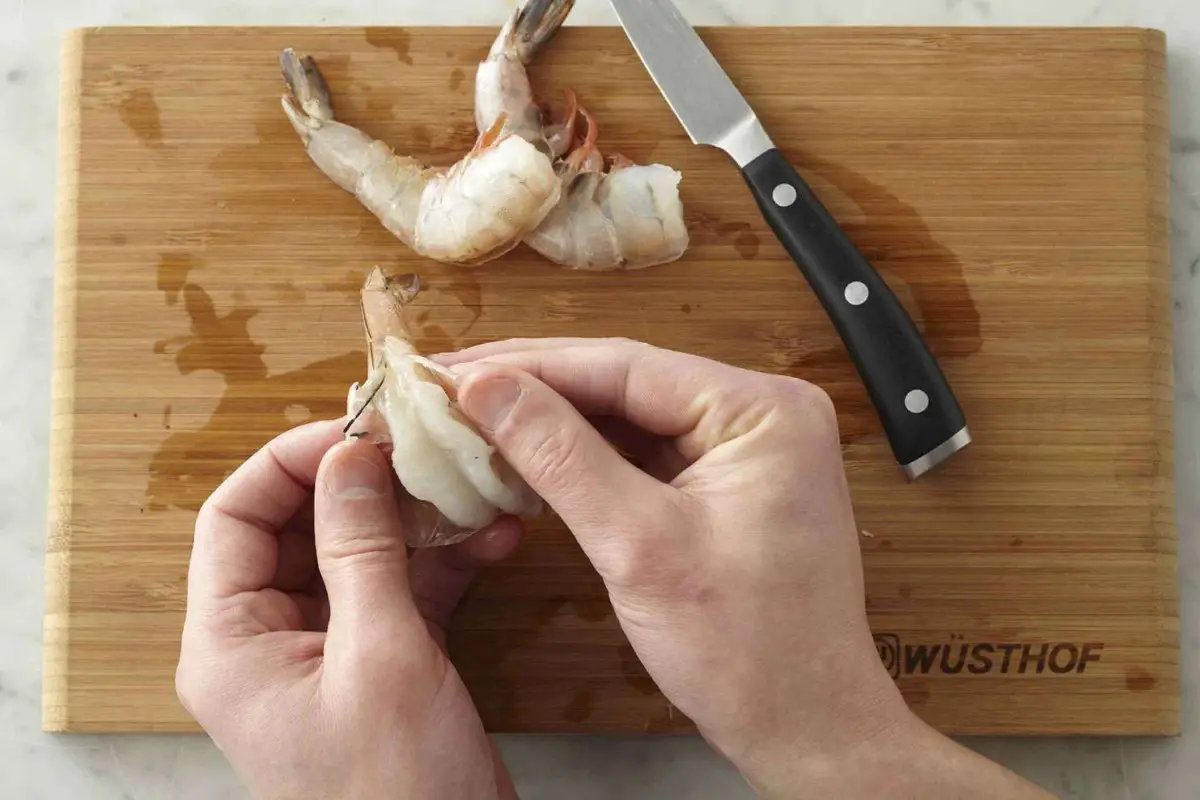Hey there, fellow seafood lovers! I’ve been cooking shrimp for years, and let me tell ya – deveining shrimp used to give me the heebie-jeebies But after tons of trial and error (and some awesome tips from my mom), I’ve figured out the easiest ways to get those pesky veins out. So, let’s dive right in!
What’s That Black Line in My Shrimp Anyway?
Before we get our hands dirty, let’s clear something up. That dark line running down your shrimp’s back? It’s not actually a vein – it’s the shrimp’s digestive tract (aka where its poop hangs out ). While it won’t hurt you to eat it, it might make your shrimp taste a bit gritty.
Do I Really Need to Devein Shrimp?
Here’s the real talk:
- For small/medium shrimp: Nah, don’t sweat it
- For jumbo/large shrimp: Yeah, probably should
- For raw preparations (like sushi): Definitely yes!
The 3 Easiest Methods to Devein Shrimp
1. The Kitchen Shears Method (My Favorite!)
This is hands-down the fastest way to both peel AND devein shrimp.
What you’ll need
- Kitchen shears
- Bowl of ice water
- Cutting board
Steps:
- Twist off the head
- Cut along the shell’s back with shears
- Peel off shell
- Remove the vein
- Rinse under cold water
2. The Toothpick Trick (Best for Shell-On Shrimp)
This is my mom’s secret technique – super clean and keeps shells intact!
Steps:
- Find the joint between 2nd and 3rd shell segments
- Pierce under the vein with a toothpick
- Lift and pull the vein out
- Done! No shell damage!
3. The Classic Knife Method (For Peeled Shrimp)
What you’ll need:
- Paring knife
- Cutting board
Steps:
- Lay shrimp on its side
- Make shallow cut (about 1/4 inch deep) along the back
- Lift out the vein
- Rinse
Pro Tips from My Kitchen to Yours
- Save those shells! They make amazing seafood stock
- Keep shrimp cold while working – use an ice-filled sheet pan
- Don’t cut too deep when deveining – just enough to expose the vein
- Always rinse after deveining to remove any grit
Common Questions I Get Asked
Q: Should I devein before or after cooking?
A: Definitely BEFORE! Raw shrimp are easier to work with and you can see the vein better.
Q: What about the white “vein” on the bottom?
A: That’s actually a blood vessel and totally fine to leave in. No need to remove it!
Q: Help! My shrimp are frozen!
A: No worries! Either:
- Thaw overnight in fridge
- Quick-thaw in cold water for 30 mins
Time-Saving Shopping Tips
If you’re really not feeling the whole deveining process (trust me, I get it!), here are some shortcuts:
- Look for “cleaned and deveined” on the package
- Buy EZ-peel shrimp (partially split and deveined)
- Fresh shrimp from fish counter often come pre-cleaned
Wrapping It Up
There ya have it – everything you need to know about deveining shrimp! My personal fave is the kitchen shears method, but honestly, any of these will work great. The most important thing is finding what works best for you.
Now go forth and cook some amazing shrimp dishes! And hey, if you’re still feeling unsure, just remember – practice makes perfect. We’ve all had to start somewhere!
Got any cool shrimp deveining tricks I didn’t mention? Drop ’em in the comments below – I’d love to hear your tips!

Do you need to devein shrimp?
No! If you’re cooking your shrimp fully (to an internal temperature of 145°F, according to the FDA), you likely do not actually need to devein shrimp from a safety perspective. If you are planning on eating the shrimp raw, the advice gets a little more complicated. Because the shrimp’s intestine contains some bacteria, some experts say that eating it raw will expose you to the risk of foodborne illness. By removing the tract, you reduce your risk of exposure. If the recipe you’re cooking calls on you to steam, boil, roast, sear, or grill, the vein is not likely to pose a health risk.
Eric Ripert, the chef and cookbook author of the soon-to-be-released Seafood Simple, makes the point that the size of the shrimp determines how he handles the cleaning. “If the shrimp is very tiny, it is not necessary to devein them because there’s usually nothing visible to remove,” he tells me.
Andrea Nguyen, the author of, most recently, Ever-Green Vietnamese, resoundingly agrees, noting that the size of the shrimp has everything to do with her choices around shrimp preparation: “Sometimes with Vietnamese cooking we use those very small shrimp, like 51–60s, and we’ll use them with the shell on. I don’t devein those, because we’re eating those shell-on. It’s not a big deal to me tastewise.”
In her cookbook Rambutan, Cynthia Shanmugalingam leaves the option to devein entirely up to the reader in recipes like her shrimp and seafood kool stew and her prawn curry with tamarind. While acknowledging that it is a common practice, she herself doesn’t bother with it, writing, “I’m usually too lazy to devein them, and the membrane isn’t harmful.”
What does it actually mean to “devein” shrimp?
This is an important question, if not a tad misleading. Deveining shrimp refers to removing the dark-colored membrane you see along the outermost curvature of the shrimp. That said, you’re not actually removing a vein at all, rather the intestinal tract of the shrimp. Most people do this to avoid the ick factor of eating what their shrimp already has, if you catch my drift. But it raises the question: Is deveining shrimp actually necessary? Will omitting this step in my shrimp preparation harm the people I’m cooking for or make the finished dish taste bad?
